5.1 Mummies
The following are photographs of mummies, purported mummies, and related images from East Asia,many of which are described in more detail in Gildow 2011, Gildow 2005 [2006] and Gildow and Bingenheimer 2002 [2005].
Webpage established: 15 January 2009 Last update:
29 March 2013
| Place the pointer over the image you wish to see in more detail. |
 |
| 5.1.1 |
|
 |
| 5.1.2 |
|
 |
| 5.1.3 |
|
 |
| 5.1.4 |
|
 |
| 5.1.5 |
|
 |
| 5.1.6 |
|
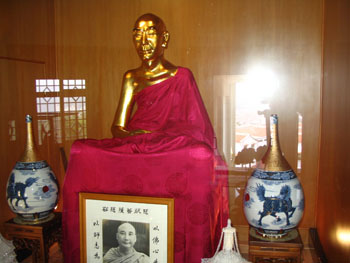 |
Fig. 5.1.1. Cihang’s mummy in a glass case, with photograph of Cihang. In Xizhi, Taipei County, Taiwan (Douglas Gildow, 7 Aug. 2005). |
 |
| 5.1.7 |
|
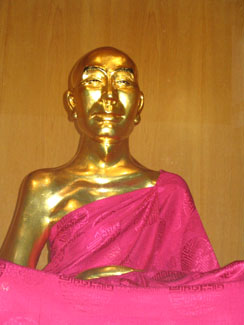 |
Fig. 5.1.2. Close-up of Cihang’s mummy. In Xizhi, Taipei County, Taiwan (Douglas Gildow, 7 Aug. 2005). |
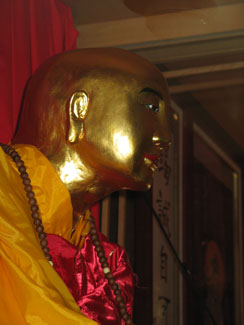 |
Fig 5.1.3. Close-up of Qingyan’s mummy. In Xindian, Taipei County, Taiwan (Douglas Gildow, 25 March 2003). |
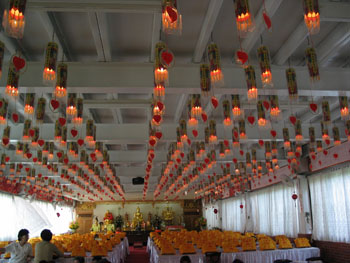 |
Fig. 5.1.5. The main hall of Anguo Monastery, adorned for a recitation ritual. The mummy of Yingmiao can be seen on the main altar in the back, to the left. In Beitou District, Taipei, Taiwan (Douglas Gildow, 27 April 2003). For more photos of Yingmiao, see Gildow and Bingenheimer 2002. |
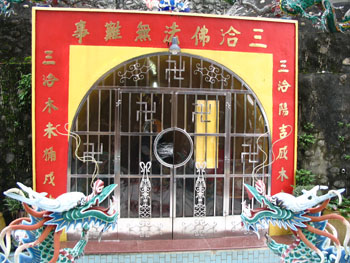 |
Fig. 5.1.6. Cell for the mummy of Puzhao, built into a cement funerary mound. In Sanqia Gongcheng Hall, Gaoxiong County, Taiwan (Douglas Gildow, 30 Aug. 2005). |
 |
| 5.1.8 |
|
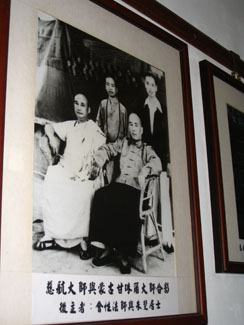 |
Fig 5.1.4. Photograph of Cihang (front left) sitting next to the Kanjurwa Khutughtu (front right). From the Mile Neiyuan, in Xizhi, Taipei County, Taiwan (Douglas Gildow, 7 Aug. 2005). |
 |
| 5.1.9 |
|
 |
| 5.1.10 |
|
 |
| 5.1.11 |
|
 |
| 5.1.12 |
|
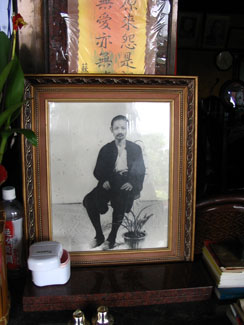 |
Fig 5.1.7. Photograph of Puzhao, at Sanqia Gongcheng Hall, Gaoxiong County, Taiwan (Douglas Gildow, 30 Aug. 2005). |
 |
| 5.1.13 |
|
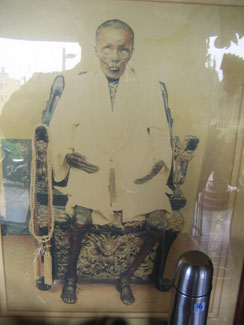 |
Fig. 5.1.8. Photograph of Puzhao’s mummy, at Sanqia Gongcheng Hall, Gaoxiong County, Taiwan (Marcus Bingenheimer, 29 March 2005). Used with permission from Bingenheimer. |
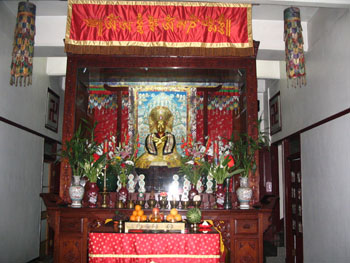 |
Fig. 5.1.10. Altar for mummy of Gongga, in Gongga Vihara, Zhonghe, Taipei County, Taiwan (Douglas Gildow, 7 July 2005). |
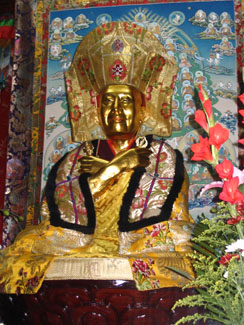 |
Fig. 5.1.11. Close-up of Gongga’s mummy, in Gongga Vihara, Zhonghe, Taipei County, Taiwan (Douglas Gildow, 7 July 2005). |
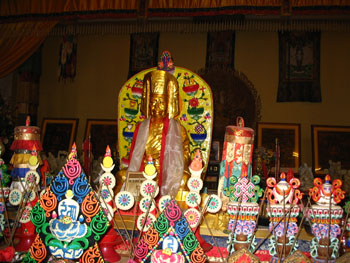 |
Fig 5.1.12. Replicate statue of Gongga’s mummy, in Tainan City, Taiwan (Douglas Gildow, 2 Sept. 2005). |
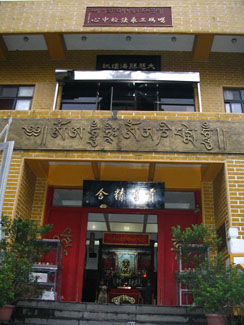 |
Fig. 5.1.9. Gongga Vihara, Zhonghe, Taipei County, Taiwan (Douglas Gildow, 7 July 2005). |
 |
| 5.1.14 |
|
 |
| 5.1.15 |
|
 |
| 5.1.16 |
|
 |
| 5.1.17 |
|
 |
| 5.1.18 |
|
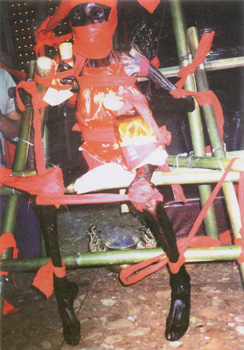 |
Fig. 5.1.13. Unlacquered mummy of Dexiu, taken from a photograph (and modified) in a booklet available from Ci’an Temple, Jilong, Taiwan (Douglas Gildow, 13 Sept. 2005). |
 |
| 5.1.19 |
|
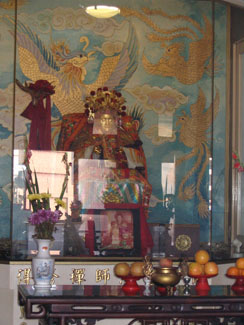 |
Fig. 5.1.14. Laquered mummy of Dexiu, with photograph of Dexiu, inside a (highly reflective!) glass case. Note the similarity to the arrangement of Cihang with his photograph seen in Fig. 5.1.1, and the resemblance to Qingyan’s mummy with a photograph of Huineng’s mummy, a photograph of which is available in Gildow and Bingenheimer 2002 [2005], p. 104. In Ci’an Temple, Jilong, Taiwan (Douglas Gildow, 13 Sept. 2005). |
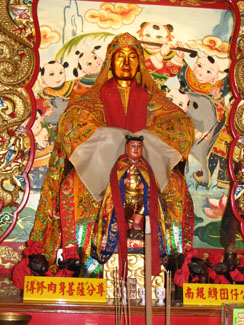 |
Fig. 5.1.15. Replicate statue of Dexiu’s mummy. In Ci’an Temple, Jilong, Taiwan (Douglas Gildow, 14 July 2005). |
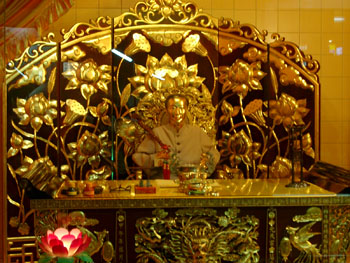 |
Fig. 5.1.16. Mummy of Mingjie enclosed in glass case. In Yuantian Temple, Tainan, Taiwan. (Photograph given to me by Marcus Bingenheimer, who received it from Zeng Mingxiong, Mingjie’s son. It was taken in 2004 or early 2005). Used with permission from Bingenheimer. |
 |
| 5.1.20 |
|
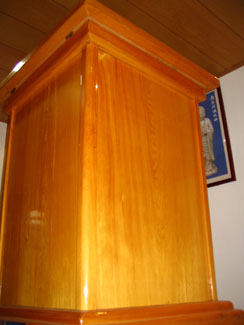 |
Fig. 5.1.17. Potential mummy enclosed in vertical casket, which in the future may be opened and the mummy enshrined. Mummies continue to be produced in Buddhist Asia. In Taipei County, Taiwan (Douglas Gildow, spring 2006). |
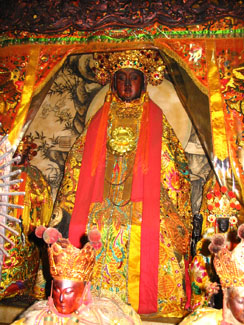 |
Fig. 5.1.18. Main statue of Cai Guanyin, whose mummy was reportedly destroyed. Her bone relics may be in an urn under her main statue. In Nantian Temple, Tainan County, Taiwan (Douglas Gildow, 3 Sept. 2005). |
 |
| 5.1.21 |
|
 |
| 5.1.22 |
|
 |
| 5.1.23 |
|
 |
| 5.1.24 |
|
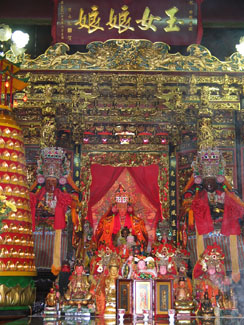 |
Fig. 5.1.19. Image of the reportedly mummified Yunü Niangniang. In Yunü Temple, Guandu, Taipei, Taiwan (Douglas Gildow, 13 Sept. 2005). |
 |
| 5.1.25 |
|
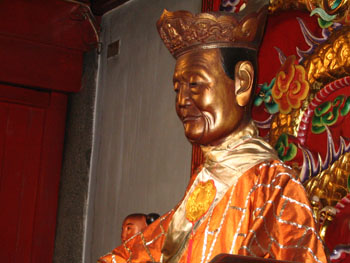 |
Fig. 5.1.20. Statue of the “flesh-body Buddha,” the deity Dingguang Gufo. In Yinshan Monastery, Danshui, Taiwan (Douglas Gildow, 21 July 2005). |
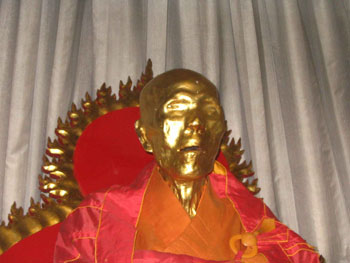 |
Fig. 5.1.21. Mummy in Thailand. More on this in the future (Douglas Gildow, 17 June 2006). |
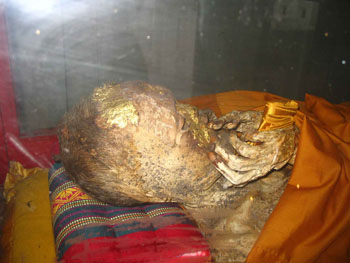 |
Fig. 5.1.22. Mummy in Thailand. More on this in the future (Douglas Gildow, 17 June 2006). |
 |
| 5.1.26 |
|
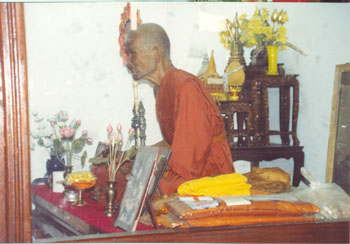 |
Fig. 5.1.24. Mummy (or wax image?) of monk in Thailand (acquired from Marcus Bingenheimer, acquired 30 April 2006). Used with permission from Bingenheimer. |
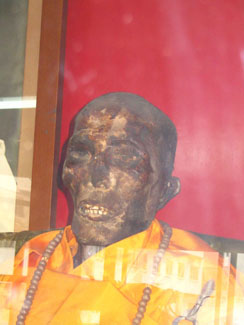 |
Fig. 5.1.23. Mummy in Thailand. More on this in the future (Douglas Gildow, 19 June 2006). |
 |
| 5.1.27 |
|
 |
| 5.1.28 |
|
 |
| 5.1.29 |
|
 |
| 5.1.30 |
|
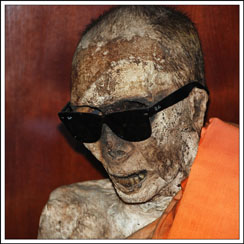 |
Fig. 5.1.25. Mummy of the Thai monk on Koh Samui, Thailand. Taken from the photo album of “grantthai,” and available on his Flikr account (http://www.flickr.com/photos/inbangkok /857939408/). Also see video clip at: http://www.youtube.com/watch?v=UNwOZW _ClkU&feature=related). |
 |
| 5.1.31 |
|
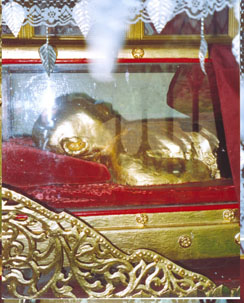 |
Fig. 5.1.26. Mummy in Burma (acquired from Marcus Bingenheimer, acquired 30 April 2006). Used with permission from Bingenheimer. |
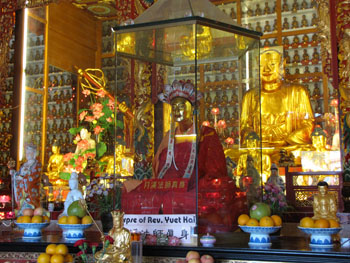 |
Fig. 5.1.27. Mummy of the monk Yuet Kai. In Wanfo si, Hong Kong (Douglas Gildow, 11 June 2009). |
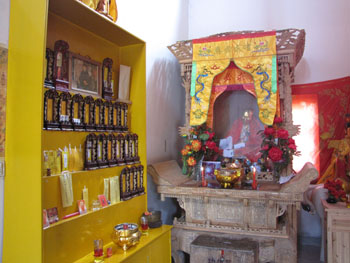 |
Fig. 5.1.30. Mummy of the monk Kuande. In Songshu an, Jiuhuashan, Anhui (Douglas Gildow, 4 July 2009). |
 |
| 5.1.32 |
|
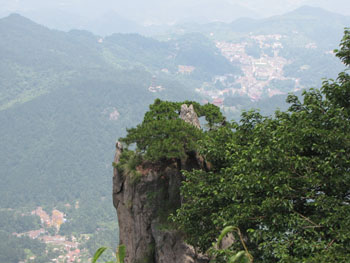 |
Fig. 5.1.28. Jiuhuashan, land of many mummies (Douglas Gildow, 2 July 2009). |
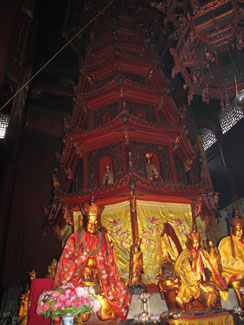 |
Fig. 5.1.29. The mummy of Jin Qiaojue/Dizang Bodhisattva is purportedly interred within this stupa. In Roushen baodian, Jiuhuashan, Anhui (Douglas Gildow, 30 June 2009). |
 |
| 5.1.33 |
|
 |
| 5.1.34 |
|
 |
| 5.1.35 |
|
 |
| 5.1.36 |
|
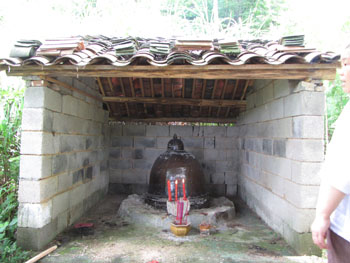 |
Fig. 5.1.31. The hut and urns in which Kuande had been interred. Nearby Songshu an, Jiuhuashan, Anhui (Douglas Gildow, 4 July 2009). |
 |
| 5.1.37 |
|
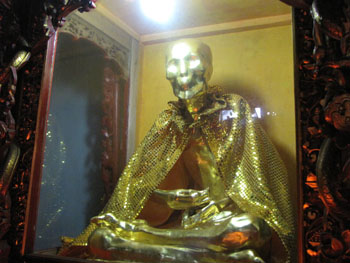 |
Fig. 5.1.32. Mummy of the nun Renyi. In Tonghui chanlin, Jiuhuashan, Anhui (Douglas Gildow, 1 July 2009).
|
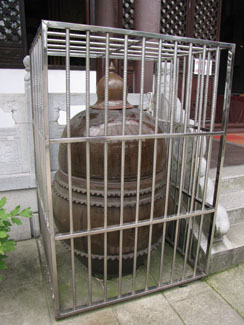 |
Fig. 5.1.33. The urns in which the nun Renyi had been interred. In In Tonghui chanlin, Jiuhuashan, Anhui (Douglas Gildow, 1 July 2009).
|
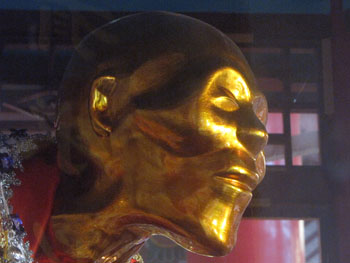 |
Fig. 5.1.34. The mummy of the monk Puwen. In Tiantai xiayuan, Jiuhuashan, Anhui (Douglas Gildow, 4 July 2009). |
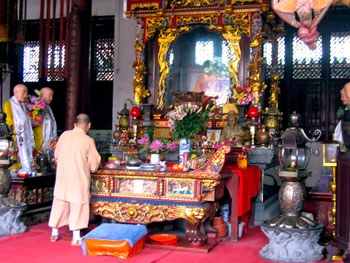 |
Fig. 5.1.35. The mummy of Huineng, enclosed in a glass case. In Nanhua Monastery, Shaoguan, Guangdong (Elizabeth Kenney, 17 July 2007). |
 |
| 5.1.38 |
|
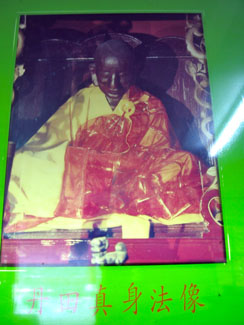 |
Fig. 5.1.36. Posted photo of the mummy of Dantian. In Nanhua Monastery, Shaoguan, Guangdong (Elizabeth Kenney, 17 July 2007).
|
 |
| 5.1.39 |
|
 |
| 5.1.40 |
|
 |
| 5.1.41 |
|
 |
| 5.1.42 |
|
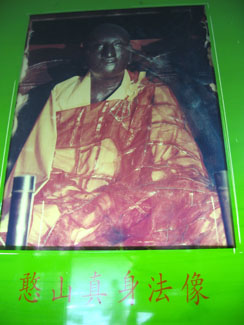 |
Fig. 5.1.37. Posted photo of the mummy of Hanshan. In Nanhua Monastery, Shaoguan, Guangdong (Elizabeth Kenney, 17 July 2007).
|
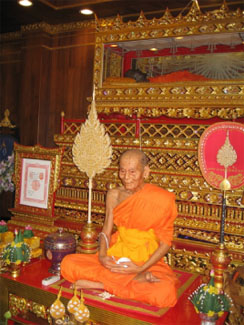 |
Fig. 5.1.38. The alleged mummy of Luang Pho Poon, in Nakhon Pathom Province, Thailand (Justin McDaniel, 2006).
|
 |
| 5.1.43 |
|
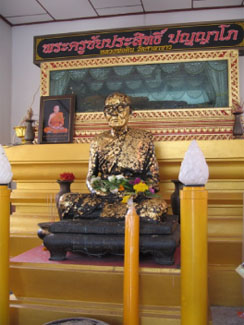 |
Fig. 5.1.39. The alleged mummy of Luang Pho Din, Chainat Province, Thailand (Justin McDaniel, 2006).
|
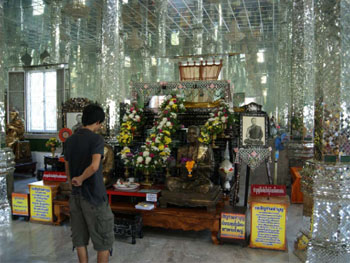 |
Fig. 5.1.40. The alleged mummy of Luang Pho Kasen, Ang Thong Province, Thailand (Justin McDaniel, 2011).
|
 |
| 5.1.44 |
|
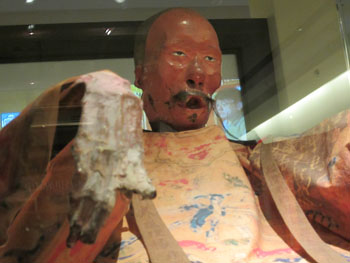 |
Fig. 5.1.41. The mummy Ke Xiang, on display in the National Taiwan Museum (Douglas Gildow, 8 March 2013). |
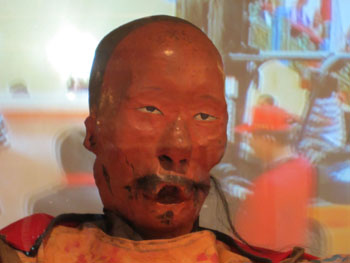 |
Fig. 5.1.42. The mummy Ke Xiang, on display in the National Taiwan Museum. A film is playing in a display behind his head (Douglas Gildow, 8 March 2013). |
 |
| 5.1.45 |
|
 |
| 5.1.46 |
|
 |
| 5.1.47 |
|
 |
| 5.1.48 |
|
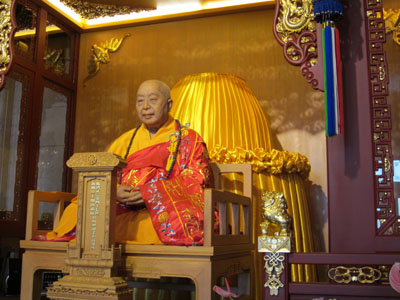 |
Fig. 5.1.43. The wax statue of the monk Wuming 悟明 (1910-2011), whose seated corpse is sealed in the special urn, now covered by yellow cloth, seen behind this image. If the corpse successfully mummifies I suspect it will be lacquered, gilded, and enshrined. This shrine is located in Haiming Monastery, Shulin District, New Taipei City (Douglas Gildow, 5 Aug. 2012).
|
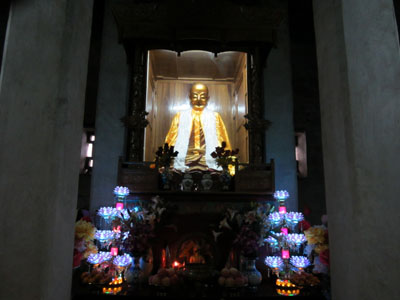 |
Fig. 5.1.44. What is purported by some locals to be the mummy of the fifth Chan patriarch, Hongren. In the True Body Hall 真身殿, Wuzu Monastery, Hubei. There is also a stupa by the nearby Sizu Monastery that monks there said once held the mummy of the fourth patriarch, Daoxin (Douglas Gildow, 16 Dec. 2012).
|
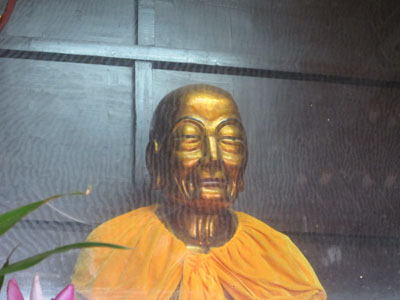 |
Fig. 5.1.45. A statue of the sixth Chan patriarch Huineng, made to look like his purported mummy that is enshrined in Guangdong Province. So here we have a statue imitating a mummy rather than a mummy imitating a statue—for a change! In Wuzu Monastery, Hubei (Douglas Gildow, 16 Dec. 2012).
|
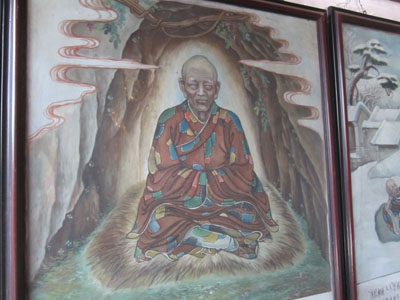 |
Fig. 5.1.48. A drawing of the deceased monk “Monk Mo” 魔和尚, who became a worshipped mummy (肉体佛, the term used in the accounts here) at the Monastery of the Pool and the Maclura Tricuspidata [Tree] 潭柘寺, in rural Beijing, according to posted accounts by attributed to local elders. The fate of the mummy, if it existed, is unknown. Part of an account next to this picture reads: 死后,寺院将魔和尚遗体,安放在西观音洞内,称为潭柘寺肉体佛。因敬仰拜香人很多,老虎洞容纳不下,方丈便在寺院内,石鱼殿和祖师殿之间,修建一座魔佛殿,把魔和尚遗体安放在殿中,… (Douglas Gildow, 24 March 2013). |
|
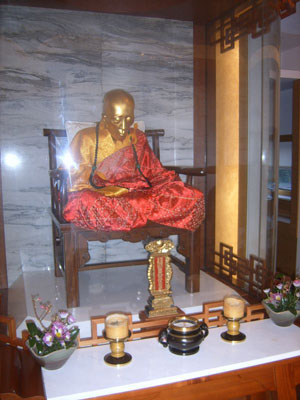 |
Fig. 5.1.46. A more recent photo of Yingmiao than Fig. 5.1.5 (above), showing the mummy in a new glass case in a new building, still at Anguo Monastery (William Ma, Jan. 2013).
|
|
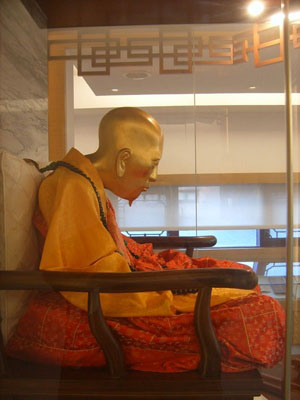 |
Fig. 5.1.47. Side view of Yingmiao (William Ma, Jan. 2013).
|
|
|
|
|
| |
|
|
|
|
|
Go to Next Album
|
|

